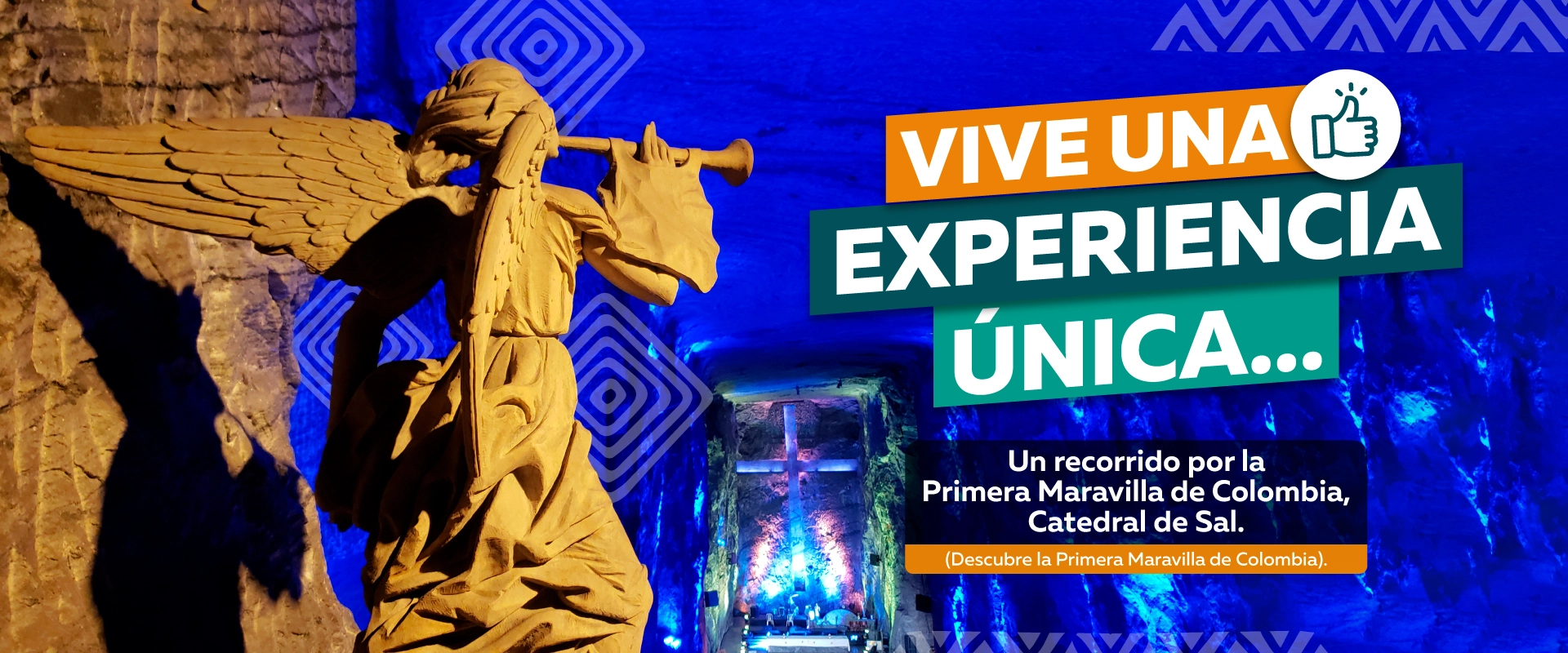How to get there?

Frequent departures from the North Portal. The trip takes approximately 1 hour.

Available on weekends, it offers a picturesque experience through savannah landscapes.

Via the North Highway, take the Zipaquirá exit. The route is direct and the roads are in good condition.
Buy your tickets
HERE



Purchase your Salt Cathedral passes
NATIONAL VISITOR
FOREIGN VISITOR
For your peace of mind, the tickets you purchase today will be active for a single
use for up to 180 days after the purchase date.
National Visitor
Quantity
Total
Adults
Children
Seniors
Disabled
Foreign Visitor
Quantity
Total
Adults
Children
Seniors
Disabled
*Conditions and restrictions apply. Please remember: The rates you purchase must match the nationality and age range. These two criteria will be verified upon entry. If there are no matches, NO REFUNDS will be issued, and a new purchase will need to be made. *Children's age range (4-12 years), adult (13-59 years), senior (> 60 years).
Salt Cathedral of Zipaquirá
To reach the Salt Cathedral, you have several options: public transportation, private vehicle, or, if you prefer, take the train from the city of Bogotá. If you come by private vehicle, keep in mind that the Cathedral offers parking services. On the other hand, if you arrive by train or public transportation, we recommend walking to enjoy the city and the natural spaces of the Parque de la Sal. Here is more information on how to get to Zipaquirá.

Maze
On the way to the Plaza del Minero, you will find a maze full of art. If you are with children, they will enjoy playing to find the exit, and if it’s just adults, no problem—the art displayed on every wall deserves your attention.

Miner's Square
After walking the path from the arch to the Plaza del Minero, you will find shops selling handicrafts, food, and also the ticket counters. Remember that to avoid lines at the counters, you can purchase your entry pass with us. We usually have promotions and additional benefits available that you will only find by buying on our Zipaquirá Turística portal.
Before entering, take a moment to appreciate the Miner's Square and the view of Zipaquirá from there.

Orpheo
In the Plaza del Minero, there is also a climbing wall, so if extreme sports are your thing, you can take some time to enjoy this attraction. Keep in mind that before entering the tunnel of the Salt Cathedral, depending on the day and time of your visit, your tour will include either a guide or an audio guide; be sure to ask at Orpeho.

Entrance Tunnel
Officially begin your journey 180 meters underground. Our recommendation, whether you are accompanied by a guide or audio guide, is to listen and observe attentively, as each carving, tunnel... has a story, and if you have chosen to visit Colombia’s First Wonder, you surely want to know what it is.

Stations of the Cross
A few meters ahead, you will find the Stations of the Cross carved in salt rock. Throughout the journey, you can appreciate the 14 stations that make it up. At the end, you will reach The Dome, a space to contemplate the grandeur of the world and the cosmos. Additionally, you will have your first glimpse of the Central Nave of the Salt Cathedral. It’s an excellent spot for a photo at the entrance or exit so you can take your time.

Coro
The journey continues toward one of the most iconic locations in the Salt Cathedral that you have surely seen in videos and photographs: the Coro. Take a moment to enjoy the view from there, and then continue walking through the salt-carved tunnels.

Nártex
It’s time to contemplate the Nártex, a work that gives the feeling of a labyrinth. According to biblical history, the unbaptized had to pass through there as an act of penance.

Chapel of the Virgin of Guasá
A few steps ahead is the Chapel of the Virgin of Guasá, one of the most important spaces for those who worked to create the mine. "La Morenita" is the patroness of miners, and the chapel aims to pay tribute to her.

Birth Nave
To continue on this journey filled with history, architecture, and spiritual connection, you will enter the naves of the Salt Cathedral. In the Nave del Nacimiento (Nave of the Nativity), you can admire the nativity scene carved in salt rock, the baptismal font located around the baptismal pool, and the crystalline salt waterfall, which represents the River Jordan.

Nave of Life
Now you arrive at the space that has gone viral through photographs and videos: the Central Nave, or Nave de la Vida (Nave of Life). Here stands the largest cross carved in salt rock. This scene deserves to be observed for several minutes. You will also see the Medallion of Creation, a work that pays tribute to Michelangelo Buonarroti of the Sistine Chapel.

Mapping Show
It is in the Central Nave where you can currently enjoy the mapping show. Regardless of the pass you purchase, you will have access to this spectacle that combines art and technology. It is scheduled for specific times, and from Zipaquirá Turística, we recommend that you plan ahead to enjoy the show. Remember, if you don't have your pass yet, you can get it on our Zipaquirá portal.

Pietat
Next to the Nave de la Vida (Nave of Life) is the Nave de la Muerte y la Resurrección (Nave of Death and Resurrection), which features the artwork Pietà, representing the descent of Christ and symbolizing the end of His earthly life.

Commercial Zone
Continuing with the tour, you will find part of the commercial area, featuring handicrafts carved in salt rock, emeralds, textiles, and even spa services 180 meters underground. This does not include the food establishments, which are perfect spaces for a brief break that will allow you to recharge and continue discovering Colombia's First Wonder.

Nucuma
Visit the theater where Nucuma is screened. It is an animated short that reveals the fascinating story of the formation of the salt dome and the extraction methods that led to the construction of the majestic and unique Salt Cathedral.

Water Mirror
In the middle of the commercial area is the Mirror of Water, a place that reflects the salt walls and ceilings when it receives a bit of light, creating a depth effect. You will enjoy observing this space!




 Catedral De Sal
Catedral De Sal


